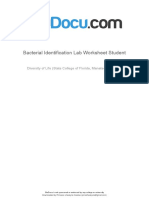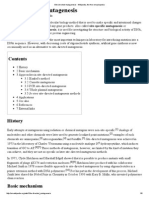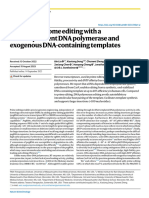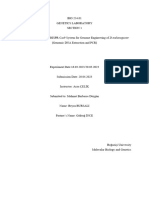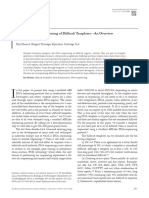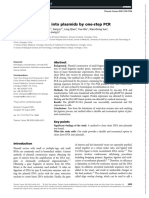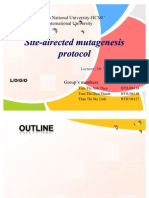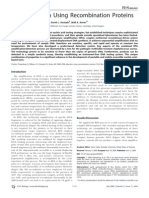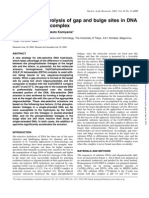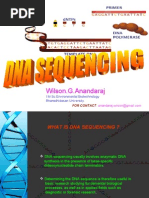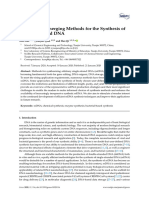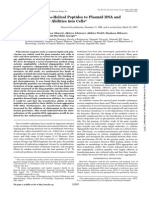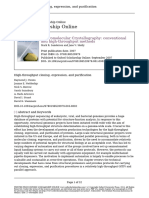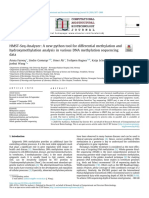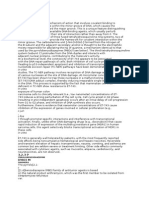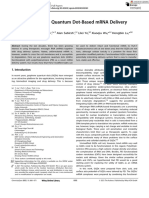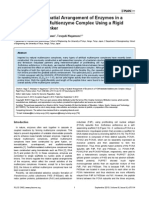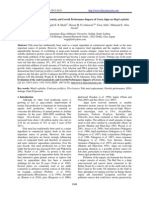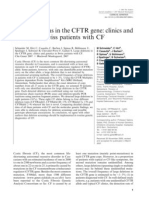X7 Polymerase
X7 Polymerase
Uploaded by
Sanjay HiraskerCopyright:
Available Formats
X7 Polymerase
X7 Polymerase
Uploaded by
Sanjay HiraskerCopyright
Available Formats
Share this document
Did you find this document useful?
Is this content inappropriate?
Copyright:
Available Formats
X7 Polymerase
X7 Polymerase
Uploaded by
Sanjay HiraskerCopyright:
Available Formats
Nrholm BMC Biotechnology 2010, 10:21 http://www.biomedcentral.
com/1472-6750/10/21
METHODOLOGY ARTICLE
Open Access
A mutant Pfu DNA polymerase designed for advanced uracil-excision DNA engineering
Morten HH Nrholm
Abstract
Background: The combined use of restriction enzymes with PCR has revolutionized molecular cloning, but is inherently restricted by the content of the manipulated DNA sequences. Uracil-excision based cloning is ligase and sequence independent and allows seamless fusion of multiple DNA sequences in simple one-tube reactions, with higher accuracy than overlapping PCR. Results: Here, the addition of a highly efficient DNA polymerase and a low-background-, large-insertioncompatible site-directed mutagenesis protocol is described, largely expanding the versatility of uracil-excision DNA engineering. Conclusions: The different uracil-excision based molecular tools that have been developed in an open-source fashion, constitute a comprehensive, yet simple and inexpensive toolkit for any need in molecular cloning.
Background Uracil-excision-based cloning was invented more than 15 years ago [1,2], but the technique was left unused, due to incompatibility with high-fidelity PCR [3,4]. In the technique, compatible single stranded DNA overhangs are created by substituting selected deoxy thymidine (dT) nucleotides with deoxy uridine nucleotides (dU) (Figure 1). Subsequently, the DNA is treated with uracil DNA glycosidase (UNG) and usually either T4 endonuclease [5] or DNA glycosylase-lyase endo VIII (commercially available as a mix with UNG as the socalled USER enzyme from New England Biolabs), which releases the sequence upstream from the dU s and allows pairing between exposed, compatible ends (and these reactions define the term uracil-excision as it is used here). The overhangs are usually designed to be 7-12 nucleotides long, and therefore can create circular DNA species that are stable enough to allow bacterial transformation without prior ligation. Hence, the technique relies solely on a pair of properly spaced deoxy adenine- and dT-nucleotides, and, due to the degeneracy of the genetic code, allow seamless translational fusions of virtually any protein coding DNA sequence, making it particular suitable for (but not
Correspondence: norholm@gmail.com Center for Biomembrane Research, Department of Biochemistry and Biophysics, Stockholm University, SE-106 91 Stockholm, Sweden
limited to) applications such as chimeric DNA fusion designs. In 1999, the crystal structure of the DNA polymerase Tgo from the archea Thermococcus gorgonarius was solved [6], revealing the nature of the uracil-binding pocket, and allowing the design of mutant Tgo- and Pfu-polymerases with reduced stalling at uracil-containing DNA [7]. With mutants like PfuV93Q, high-fidelity PCR became compatible with uracil-excision cloning. This led to development of an improved uracil-excision cloning technology [3] and to a new way of doing seamless PCR product fusion that may eventually replace overlapping PCR in many applications [8,9]. The useful application of these technologies was further demonstrated by their use in artificial gene synthesis [10]. In addition to PCR, and cloning and fusing genes, sitedirected mutagenesis is an indispensable tool for molecular biologists. One of the early methods for doing sitedirected mutagenesis was the Kunkel method [11] that uses template DNA isolated from a ung- dut- E. coli strain. This strain lacks dUTPase and uracil deglycosidase and therefore accumulates soluble dUTP and DNA-bound dU nucleotides. In the method, dU-containing DNA is used as template in a linear amplification reaction with a mutagenic primer, as well as the Klenow enzyme, dNTPs and a ligase. Subsequently, the DNA is transformed into ung+ bacteria, where only the newly synthesized, mutant DNA
2010 Nrholm; licensee BioMed Central Ltd. This is an Open Access article distributed under the terms of the Creative Commons Attribution License (http://creativecommons.org/licenses/by/2.0), which permits unrestricted use, distribution, and reproduction in any medium, provided the original work is properly cited.
Nrholm BMC Biotechnology 2010, 10:21 http://www.biomedcentral.com/1472-6750/10/21
Page 2 of 7
Figure 1 Principle of uracil-excision based DNA fusion. In uracilexcision based DNA fusions, dU nucleotides replace selected thymidine nucleotides in DNA and is subsequently removed by e.g. the USER enzyme, leaving the upstream nucleotide sequence unstable. When the resulting, compatible single stranded overhangs are combined they can be transformed directly into bacteria without prior ligation to yield a stable recombinant molecule.
survives and the primer-introduced mutation is isolated. Later, PCR entered the scene and variants, known as inverse PCR or whole plasmid synthesis (WHOPS), largely seems to have replaced the Kunkel method. In the typical PCR-based approach, template carry-over is inhibited by treatment with the restriction enzyme DpnI, that restricts dam methylated plasmid DNA, but leaves unmethylated PCR-derived DNA intact. Uracil-excision can be used in several ways as a simple, versatile and large-insertion compatible site-mutagenesis WHOPS method. The method offers several advantages compared to previous WHOPS protocols (Figure 2A-E). First, whereas traditional exponential amplification WHOPS uses two unique primers for each mutation (Figure 2A), uracil-excision offers the opportunity to reuse one primer when several mutations need to be introduced in one location (Figure 2B). Second, the primers do not to overlap in their 3-end, and, hence, are shorter and should perform better in PCR (Figure 2B). Third, given the limitation in DNA-synthesis chemistry, the reduced size of the primers offers the opportunity to create larger insertion mutations (Figure 2C) and offers the same possibilities with deletions (Figure 2D). Fourth, uracil-excision can be used for very large insertions (Figure 2E, [4,8,9]), free from the inherent limitations in overlapping PCR. However, most importantly, the protocol is highly versatile and insertions can be created from a variety of DNA species, ranging from small, perfectly complementary DNA oligonucleotides, over mediumrange DNA species created by enzymatic extension of oligonucleotides that only overlap in their 3end, to DNA of virtually any length created by PCR - and several different
Figure 2 Principle of whole plasmid synthesis (WHOPS) and uracil-excision based site-directed mutagenesis (U-SM). (A) In WHOPS, two usually perfectly overlapping oligonucleotides are used to amplify an entire plasmid. WHOPS is used for site-directed mutagenesis by placing mutations (illustrated with an X) in the middle of the two primers. (B) Oligonucleotides for U-SM need only to overlap in the complementary region between the selected Aand T-nucleotides and only one primer needs to carry the mutation. (C) U-SM is compatible with making insertions (illustrated with a loop) and (D) deletions (missing sequence illustrated with a dashed line). (E) Larger insertions, such as in e.g. whole gene fusions, are made by a simple combination of the U-SM principle and uracilexcision based cloning - or even multiple fragments (not shown) as in the uracil-excision based PCR fusion principle.
approaches can be combined in one-tube format to introduce various changes in one reaction. Here, uracil-excision-based artificial gene synthesis is used to create a combination of a PfuV93Q mutant [7] and a highly processive Pfu-SSo7d fusion polymerase [12]. This new DNA-polymerase has several properties that make it uniquely suitable for several of the described applications, including site-directed mutagenesis of large plasmids, and a combination of the modern WHOPS mutagenesis and the classical Kunkel-method to avoid carry-over of template DNA.
Results
Fusing the DNA-binding protein Sso7d to PfuV93Q yields a highly efficient polymerase for use in uracil-excision DNA engineering
One of the drawbacks of uracil-excision molecular cloning and PCR fusion, is that it is only compatible with two different, commercially available DNA polymerases: the nonproof-reading Taq polymerase (Taq) and the proof-reading polymerase PfuCX (Stratagene), both which suffer from having low processivity [12]. Recently, the processivity of both Taq and Pfu was greatly improved by fusing the enzymes to the small DNA-binding protein Sso7d (yielding S7-Taq and PfuS7), derived from the thermophilic archea Sulfolobus solfataricus [12]. In our lab, it has been found that the commercial version of the Pfu fusion protein (Phusion, Finnzymes), performs significantly better
Nrholm BMC Biotechnology 2010, 10:21 http://www.biomedcentral.com/1472-6750/10/21
Page 3 of 7
in WHOPS of large (5-15 kb) plasmids. Hence, the uracilbinding pocket mutation (V93Q) version of PfuS7 will greatly improve the performance of the uracil-excision toolkit, in particular in challenging PCR reactions such as site-directed mutagenesis on large plasmids. A V93Q version of Pfu was first created in a pET-expression vector system by standard WHOPS. Subsequently, due to the lack of an Sso7d DNA template, a uracil-excision based artificial gene synthesis strategy was employed to add an artificial Sso7d gene to the 3end of the PfuV93Q expression construct (Figure 3A and Additional file 1). This example demonstrates that uracil-excision technology can be used to create entirely artificial genes and this approach is compatible in one-tube format with the other uracilexcision applications such as PCR fragment cloning and site-directed mutagenesis, expanding the versatility of the technology. Using standard Pfu polymerase conditions, we next compared the performance of the purified PfuV93QS7 enzyme (termed PfuX7) with the commercial PfuTurbo (PfuT, Stratagene), PfuS7 (Phusion), the commercial PfuV93Q-Turbo (PfuCX, Stratagene), and PfuV93Q using both standard and uracil-containing primers, in a
challenging mutagenesis reaction, on a large (approximately 10 kb) E. coli-yeast shuttle vector pTEF423 [13] harboring the plant gene CRE1 [14]. The two nearly identical primer pairs were designed to fit either a uracil-excision strategy or a very similar WHOPS strategy [15], and used to introduce a total of 12 mutations in 5 neighboring codons in the CRE1 sequence. Standard 1% agarose gel electrophoresis analysis of the products showed that the two Sso7d fusion polymerases were able to amplify the plasmid with standard primers, whereas only PfuX7 amplified the plasmid with uracil-containing primers (Figure 3B). Various conditions were tried, including cycling conditions with very long extension times, but it was never possible to amplify the plasmid with a non-Sso7d polymerase.
PfuX7 polymerase is compatible with the Kunkel-method to limit carry-over of unwanted template DNA
Figure 3 A new Pfu-sso7d fusion DNA polymerase that is compatible with uracil-excision cloning. (A) Illustration of the modular structure of the Pfu-sso7d DNA polymerase and the oligonucleotides used to fuse the Sso7d gene to Pfu. (B) Agarose gel electrophoresis of whole plasmid synthesis PCRs performed with five different Pfu-based DNA polymerases and either standard (normal) oligonucleotides or dU-containing primers. The five different DNA polymerases are PfuTurbo (T), Phusion (S7), PfuTurboCX (TX), Pfu-(V93Q) (X) or PfuX7 (7) and the molecular marker (M) is kb+ (Invitrogen).
Previously, two methods have been used to limit template carry-over in site-directed mutagenesis reactions. In the classical Kunkel-method, the template is isolated from a ung- dut- strain of E. coli such as CH236 (New England Biolabs), which makes it incompatible with retransformation into normal ung+ bacteria. Exponential WHOPS mutagenesis takes advantage of the DpnI restriction enzyme to restrict methylated template DNA. The combined use of dU-containing DNA with DpnIrestriction was previously demonstrated with a linear amplification mutagenesis strategy [16], but the PfuV93Q versions allow PCR-based site-directed mutagenesis to be combined with both template elimination methods and hence, will greatly decrease the recovery of unwanted template DNA. A simple screen was designed to test this idea, based on a single nucleotide mutation of the green fluorescent protein turning the codon coding for Tyrosine 40 into a TAG stop codon. In the screen, mutants are easily identified as non-fluorescent colonies (Figure 4A). A GFP expression vector [17] was isolated from both CJ236 and the common ung+ cloning strain DH5 a and used as template in a common 13-cycle protocol with Pfu-Turbo or PfuX7. As expected, only PfuX7 was able to amplify DNA isolated from the CJ236 strain (Figure 4B). Similar results were obtained comparing PfuX7 to Phusion/PfuS7 polymerase (see Additional file 2). Next, aliquots of the reactions were treated with DpnI and the DpnI-treated and untreated reactions were transformed into the BL21 strain. The screen confirmed that very few templatecontaining colonies were isolated from reactions based on DNA isolated from CJ236, whereas a large proportion of the colonies formed from the DH5a-DNA based reactions exhibited the wildtype, fluorescent phenotype (Figure 4A). Quantifications of the results showed that
Nrholm BMC Biotechnology 2010, 10:21 http://www.biomedcentral.com/1472-6750/10/21
Page 4 of 7
in all cases, using DNA from CJ236 or DpnI-treatment, resulted in more than 90% mutant recovery (Figure 4C).
PfuX7 allows the use of dUTP instead of dTTP in PCR
PCR revolutionized molecular cloning and largely defined the field of forensic genetics and allowed the analysis of ancient DNA samples of low quality and quantity. However, the efficiency of PCR creates a risk of contamination with previous samples and is of particular concern in e.g. forensic genetics. Several methods have been developed to prevent PCR carry-over contamination. In a widely used method, dUTP replaces dTTP in PCR, and prior to a new reaction UNG-treatment destroys all dU-containing, contaminating DNA species [18]. PfuX7 accepts the replacement of dTTP with dUTP in PCR, and therefore is compatible with UNGbased carry over contamination prevention. This was demonstrated with a standard PCR, with or without dTTP replaced by dUTP. In the experiment, PfuX7 was compared to the other highly processive Phusion polymerase using standard Phusion PCR conditions. Agarose gel electrophoresis confirmed that only PfuX7 was able to perform PCR with dUTP instead of dTTP (Figure 5).
Discussion In one of the early PCR-based mutagenesis protocols, WHOPS was performed with non-overlapping phosphorylated primers and was followed by a ligation step
Figure 4 PfuX7 polymerase is compatible with the Kunkel method for template elimination in site-directed mutagenesis. (A) Screen designed to calculate the efficiency of site-directed mutagenesis. By introducing a stop codon mutation in a plasmid responsible for constitutive expression of the green fluorescent protein in E. coli cells, the efficiency of the mutagenesis is easily calculated as the ratio of non-fluorescent cells to total amount of cells. Shown, is a typical example of an experiment using template DNA isolated from either DH5a or CJ236. (B) Agarose gel electrophoresis of PCRs performed with the PfuTurbo- (T) or the PfuX7 (7) DNA polymerases using template plasmid DNA isolated from the ung+ E. coli strain DH5a or the ung- strain CJ236. The molecular marker (M) is kb+ (Invitrogen). (C) Quantification of the efficiency of site-directed mutagenesis using the PfuTurbo- or the PfuX7 DNA polymerases using template plasmid DNA isolated from the ung+ E. coli strain DH5a or the ung- strain CJ236, with or without DpnI treatment. Data represents the average of three independent experiments with standard deviations.
Figure 5 PfuX7 accepts dUTP in place of dTTP in PCR. Agarose gel electrophoresis of PCRs performed with the Phusion (S7) or the PfuX7 (7) DNA polymerases and either standard dNTPs or with a dUTP/dNTP mix where dUTP replaces dTTP. The molecular marker (M) is kb+ (Invitrogen).
Nrholm BMC Biotechnology 2010, 10:21 http://www.biomedcentral.com/1472-6750/10/21
Page 5 of 7
prior to transformation of the mutant DNA [15] - the method became available as the Exsite PCR-based SiteDirected Mutagenesis Kit (Stratagene) and a similar product is today available as the Phusion Site-directed Mutagenesis Kit (Finnzymes). The uracil-excision sitedirected mutagenesis approach is very similar. However, compared to the latter technique, ligation is not necessary and the uracil-defined overlaps add an extra quality insurance step since erroneous mismatching extensions on the amplified plasmid will not yield stable recombinant molecules [8]. In the older approach, any phosphorylated DNA species can be ligated to create a circular recombinant molecule. Today, probably the most widely used technique is WHOPS with a perfectly overlapping primer pair that negates the need for ligation prior to transformation commercially available from e.g. Stratagene as the QuikChange Site-Directed Mutagenesis Kit. Due to the exponential nature of WHOPS, and the availability of modern high-fidelity DNA polymerases, such as the highly processive Pfu-Sso7d fusion protein DNA polymerase [12], this is a highly efficient technology, but the technique is not as versatile as uracil-excision. In site-directed mutagenesis, the DpnI template removal step adds extra time to the procedure and template carryover is an error frequently observed in our lab. PfuX7 allows the combined use of DpnI-treatment and dU-containing DNA to avoid carry-over of template. In our experimental setup, both the Kunkel-method and the use of DpnI was more than 90% efficient in the prevention of template recovery, and it was therefore not possible to detect a large effect of the combined use. However, in a
Table 1 Oligonucleotides used in this work
Oligonucleotide Cre1YILY-1UF Cre1YILY-1UR Cre1YILY-1XF Cre1YILY-1XR Pfu-V93Q-F Pfu-V93Q-R Pfu-upstream-F Pfu-R Pfu-F Pfu-downstream-R Sso7d-1F Sso7d-1R Sso7d-2F Sso7d-2R Sso7d-3F Sso7d-3R GFP-Y40STOP-F GFP-Y40STOP-R Sequence (5-3)
linear amplification mutagenesis strategy, the combined use of DpnI and dU-DNA was previously reported to increase the efficiency of a mutagenesis from 38% (DpnI alone) to 70-91% [16]. Therefore, the Kunkel-approach to limit tempate carry-over could be a useful and time-saving alternative or addition to DpnI-treatment, in site-directed mutagenesis. Pfu-Sso7d fusion polymerases, such as Phusion, are marketed as polymerases for direct PCR on complex samples such as blood. Indeed, we have found that in some cases PfuX7 is the only DNA polymerase that produces a PCR product in combination with DNA isolated from e.g. plant material (Nour-Eldin, H. H., personal communication), human cDNA (Lange, J. B., personal communication) or when doing WHOPS on large plasmid DNA templates (this work). Forensic PCR deals with complex samples of low quantity and quality, and prevention of carry-over contamination from previous PCRs is important to this field. PfuX7 polymerase performs better than other DNA polymerases in virtually all applications in our laboratory. Furthermore, none of the wildtype Pfu-based versions (including Phusion) have ever been able to amplify dU-containing DNA. Hence, PfuX7 polymerase may be useful in forensic PCR, both due to its high performance as well as compatibility with the well-established UNG-method for prevention of carry-over contamination.
Conclusions The combination of the USER enzyme and the new PfuX7 polymerase described here, constitutes a simple, yet comprehensive molecular toolkit that enables one-tube, ligase-
ATTGGTTTCdUTGGTGTATATACTGTATGGTGGTGCAGCTATGCACATAGTAAAAGTCGAAGATGATTT AGAAACCAAdUCGCAAAGAACAATGG PO4TGGTGTATATACTGTATGGTGGTGCAGCTATGCACATAGTAAAAGTCGAAGATGATTT PO4-AGAAACCAATCGCAAAGAACAATGG GTGGAAACTTTATTTGGAACATCCCCAAGATCAGCCCACTATTAGAGAAAAAGT ACTTTTTCTCTAATAGTGGGCTGATCTTGGGGATGTTCCAAATAAAGTTTCCAC GCGTTACTGCCTGGGGAAGA ACCGCCGGdUACCGGATTTTTTAATGTTAAGCCAGGAAG AGCAGAAAAAGdUAGCAATTCGTCGTGCATCTGTTTG GGCCCCAAGGGGTTATGCTA ACCGGCGGdUGGCGGTGCAACCGTAAAGTTCAAGTACAAAGGCGAAGAAAAAGAGGTAGACATCTCCAAGATCAAGAAAGT ACTTTCTTGAdUCTTGGAGATGTCTACCTCTTTTTCTTCGCCTTTGTACTTGAACTTTACGGTTGCACCGCCACCGCCGGT ATCAAGAAAGdUATGGCGTGTGGGCAAGATGATCTCCTTCACCTACGACGAGGGCGGTGGCAAGACCGGCCGT ACGGCCGGTCdUTGCCACCGCCCTCGTCGTAGGTGAAGGAGATCATCTTGCCCACACGCCATACTTTCTTGAT AGACCGGCCGdUGGTGCGGTAAGCGAAAAGGACGCGCCGAAGGAGCTGCTGCAGATGCTGGAGAAGCAGAAAAAGT ACTTTTTCTGCdUTCTCCAGCATCTGCAGCAGCTCCTTCGGCGCGTCCTTTTCGCTTACCGCACCACGGCCGGTCT GGGTGAAGGTGATGCTACATAAGGAAAGCTTACC GGTAAGCTTTCCTTATGTAGCATCACCTTCACCC
Nrholm BMC Biotechnology 2010, 10:21 http://www.biomedcentral.com/1472-6750/10/21
Page 6 of 7
free cloning [3], easy conversion or design of compatible vectors [3], seamless PCR fusions [8,9], artificial gene synthesis [10], site-directed mutagenesis and prevention of carry-over contamination. No other single molecular cloning technology exhibits a comparable versatility.
ligated into the pET-Pfu-(V93Q) vector with the Quick ligase kit and transformed into a standard E. coli cloning strain. The sequence of the Pfu-Sso7d fusion (termed PfuX7) was confirmed by standard DNA sequencing.
Expression and purification of the PfuX7 polymerase
Methods
Poly chain reactions
For comparison of the performance of different Pfu polymerase versions, a 30-cycle PCR was performed with a final concentration of 10 ng/l pTEF423-CRE1 plasmid (a kind gift from Prof. Tatsuo Kakimoto) with a dU-containing mutagenic primer pair Cre1YILY-1UF and Cre1YILY-1UR or a phosphorylated primer pair Cre1YILY-1XF and Cre1YILY-1XR (Table 1), all at a final concentration of 0.5 M. Cycling conditions included a 30 second 96C template denaturation step, a 30 second 58C annealing step and a 5 minute and 30 second long primer extension step at 72C. The reaction was performed with a final concentration of 0.4 mM dATP, 0.4 mM dTTP, 0.4 mM dCTP, 0.4 mM dGTP, 20 mM Tris/HCl pH 8.8, 10 mM KCl, 6 mM (NH 4 ) 2 SO 4 , 2 mM MgSO 4 , 0.1 mg/ml BSA and 0.1% Triton X-100. PCR with dUTP replacing dTTP was performed using standard Phusion (Finnzymes) reaction conditions as recommended by the manufacturer, using the dUTP/ dNTPs mix (Fermentas) instead of dNTPs. The pETPfu-vector was a kind gift from Jens Lykke-Andersen. The QuikChange Site-Directed Mutagenesis Kit (Stratagene) was used to introduce the V93Q mutation in pET-Pfu, with the primers Pfu-V93Q-F and Pfu-V93QR, and a stop codon in GFP with the primers GFPY40STOP-F and GFP-Y40STOP-R (Table 1).
Uracil-excision-based artificial gene synthesis
The pET-PfuV93Q and pET-PfuX7 plasmids were transformed into BL21 cells and transformants were inoculated in LB with ampicillin (50 g/ml) overnight (ON). An ON culture was back diluted to an optical density of 0.1 at 600 nm and grown to OD 0.3, before protein expression was induced with 0.5 mM isopropyl b-D-1thiogalactopyranosid for three hours. The culture was then centrifuged at 15.000 g for 10 minutes, the supernatant discarded and the pellet stored at -80C ON. The his- tagged protein was purified under native conditions using the Qiagen Ni-NTA Spin Kit according to the manufacturers prescriptions. The protein was desalted on Vivaspin 20 columns (Sartorius) columns and stored at -20C in a solution of 50% glycerol, 100 mM Tris/ HCl pH 8.0, 0.2 mM EDTA, 2 mM DTT, 0.2% NP40, 0.2% Tween 20. The protein activity was tested in a dilution series under standard Pfu PCR conditions (as described above) to obtain the optimal performance.
Additional file 1: Nucleotide sequences of PfuX7 and the oligonucleotides creating the sso7d gene. Contains the details of the nucleotide sequence of PfuX7 in pdf format. Click here for file [ http://www.biomedcentral.com/content/supplementary/1472-6750-1021-S1.PDF ] Additional file 2: Comparison of the DNA polymerases PfuTurbo, Phusion and PfuX7 in a site-directed mutagenesis PCR. Shows the comparison of PfuTurbo, Phusion (PfuS7) and PfuX7 in a site-mutagenesis PCR in pdf format. Click here for file [ http://www.biomedcentral.com/content/supplementary/1472-6750-1021-S2.PDF ]
Sso7d was fused to the C-terminus of PfuV93Q by amplifying part of the sequence upstream from the fusion site with the primers Pfu-upstream-F and Pfu-R, and part of the sequence downstream from the fusion site with the primers Pfu-F and Pfu-downstream-F (Table 1 and Figure 3A). Next, PCR products were mixed with varied concentrations of three pairs of complementary oligonucleotides (Sso7d-1F + Sso7d-1R, Sso7d-2F + Sso7d-2R and Sso7d-3F + Sso7d-3R, Table 1) and treated with the USER enzyme (New England Biolabs, NEB). Fragments were ligated using the Quick ligase kit (NEB), gel purified the product using the Qiagen gel purification kit and finally used as template in a standard Phusion PCR with the primers Pfu-upstream-F and Pfu-downstream-R. The resulting PCR products and the pET-Pfu vector was treated with the SacI- and BlpIFastdigest restriction enzymes (Fermentas) and subsequently fragments of the expected size were gel purified as described above. Finally, the Pfu-Sso7d fragment was
Acknowledgements Prof. Tatsuo Kakimoto is thanked for providing the pTEF423-CRE1 plasmid and Jens Lykke-Andersen is thanked for providing the pET-Pfu expression construct. Joanna Slusky, Roger Draheim and Gunnar von Heijne are thanked for comments on the manuscript. The work was supported by a grant from the Lundbeck Foundation. Received: 21 October 2009 Accepted: 16 March 2010 Published: 16 March 2010 References 1. Nisson PE, Rashtchian A, Watkins PC: Rapid and efficient cloning of AluPCR products using uracil DNA glycosylase. PCR Methods Appl 1991, 1(2):120-123. 2. Smith C, Day PJ, Walker MR: Generation of cohesive ends on PCR products by UDG-mediated excision of dU, and application for cloning into restriction digest-linearized vectors. PCR Methods Appl 1993, 2(4):328-332. 3. Nour-Eldin HH, Hansen BG, Norholm MH, Jensen JK, Halkier BA: Advancing uracil-excision based cloning towards an ideal technique for cloning PCR fragments. Nucleic Acids Res 2006, 34(18):e122.
Nrholm BMC Biotechnology 2010, 10:21 http://www.biomedcentral.com/1472-6750/10/21
Page 7 of 7
4. 5.
6.
7. 8.
9.
10. 11. 12.
13.
14.
15.
16.
17.
18.
Bitinaite J, Nichols NM: DNA cloning and engineering by uracil excision. Curr Protoc Mol Biol 2009, Chapter 3(Unit 3):21. Watson DE, Bennett GN: Cloning and assembly of PCR products using modified primers and DNA repair enzymes. Biotechniques 1997, 23(5):858-862. Hopfner KP, Eichinger A, Engh RA, Laue F, Ankenbauer W, Huber R, Angerer B: Crystal structure of a thermostable type B DNA polymerase from Thermococcus gorgonarius. Proc Natl Acad Sci USA 1999, 96(7):3600-3605. Fogg MJ, Pearl LH, Connolly BA: Structural basis for uracil recognition by archaeal family B DNA polymerases. Nat Struct Biol 2002, 9(12):922-927. Bitinaite J, Rubino M, Varma KH, Schildkraut I, Vaisvila R, Vaiskunaite R: USER friendly DNA engineering and cloning method by uracil excision. Nucleic Acids Res 2007, 35(6):1992-2002. Geu-Flores F, Nour-Eldin HH, Nielsen MT, Halkier BA: USER fusion: a rapid and efficient method for simultaneous fusion and cloning of multiple PCR products. Nucleic Acids Res 2007, 35(7):e55. Bang D, Church GM: Gene synthesis by circular assembly amplification. Nat Methods 2008, 5(1):37-39. Kunkel TA: Rapid and efficient site-specific mutagenesis without phenotypic selection. Proc Natl Acad Sci USA 1985, 82(2):488-492. Wang Y, Prosen DE, Mei L, Sullivan JC, Finney M, Horn Vander PB: A novel strategy to engineer DNA polymerases for enhanced processivity and improved performance in vitro. Nucleic Acids Res 2004, 32(3):1197-1207. Mumberg D, Muller R, Funk M: Yeast vectors for the controlled expression of heterologous proteins in different genetic backgrounds. Gene 1995, 156(1):119-122. Inoue T, Higuchi M, Hashimoto Y, Seki M, Kobayashi M, Kato T, Tabata S, Shinozaki K, Kakimoto T: Identification of CRE1 as a cytokinin receptor from Arabidopsis. Nature 2001, 409(6823):1060-1063. Weiner MP, Costa GL, Schoettlin W, Cline J, Mathur E, Bauer JC: Sitedirected mutagenesis of double-stranded DNA by the polymerase chain reaction. Gene 1994, 151(1-2):119-123. Li F, Liu SL, Mullins JI: Site-directed mutagenesis using uracil-containing double-stranded DNA templates and DpnI digestion. Biotechniques 1999, 27(4):734-738. Crameri A, Whitehorn EA, Tate E, Stemmer WP: Improved green fluorescent protein by molecular evolution using DNA shuffling. Nat Biotechnol 1996, 14(3):315-319. Longo MC, Berninger MS, Hartley JL: Use of uracil DNA glycosylase to control carry-over contamination in polymerase chain reactions. Gene 1990, 93(1):125-128.
doi:10.1186/1472-6750-10-21 Cite this article as: Nrholm: A mutant Pfu DNA polymerase designed for advanced uracil-excision DNA engineering. BMC Biotechnology 2010 10:21.
Submit your next manuscript to BioMed Central and take full advantage of:
Convenient online submission Thorough peer review No space constraints or color gure charges Immediate publication on acceptance Inclusion in PubMed, CAS, Scopus and Google Scholar Research which is freely available for redistribution
Submit your manuscript at www.biomedcentral.com/submit
You might also like
- Bacterial Identification Lab Worksheet StudentDocument10 pagesBacterial Identification Lab Worksheet StudentPrincess Lheakyrie CasilaoNo ratings yet
- BIOL 200 Molecular Biology Lecture NotesDocument44 pagesBIOL 200 Molecular Biology Lecture NotesDantong JiaNo ratings yet
- Justice Jensen - Virtual Notebook 113 - 10046426.3Document6 pagesJustice Jensen - Virtual Notebook 113 - 10046426.3Justice JensenNo ratings yet
- Site-Directed Mutagenesis - Wikipedia, The Free EncyclopediaDocument6 pagesSite-Directed Mutagenesis - Wikipedia, The Free EncyclopediaAlviro CossemeNo ratings yet
- Targeted Genome Editing With A DNA-dependent DNA Polymerase and Exogenous DNA-containing TemplatesDocument21 pagesTargeted Genome Editing With A DNA-dependent DNA Polymerase and Exogenous DNA-containing TemplatesSabranth GuptaNo ratings yet
- Rapid Construction of Insulated Genetic Circuits Via Synthetic Sequence-Guided Isothermal AssemblyDocument9 pagesRapid Construction of Insulated Genetic Circuits Via Synthetic Sequence-Guided Isothermal AssemblyShampa SenNo ratings yet
- BIO 254 Experiment - 2Document15 pagesBIO 254 Experiment - 2bursalibeyza494No ratings yet
- Development of A Rapid and Inexpensive Method To Reveal Natural Antisense TranscriptsDocument8 pagesDevelopment of A Rapid and Inexpensive Method To Reveal Natural Antisense Transcriptschandran.vkrsdNo ratings yet
- ARTIGO_Sequenciamento Sequencias DificeisDocument11 pagesARTIGO_Sequenciamento Sequencias DificeisAmanda MunizNo ratings yet
- Single-Stranded Dna (Ssdna) Production in Dna Aptamer GenerationDocument9 pagesSingle-Stranded Dna (Ssdna) Production in Dna Aptamer Generationsubramaniyam.ek2821No ratings yet
- Site-Directed Mutagenesis: Volume 5, Issue10, 2017, PP 7-9 ISSN No. (Online) 2349-0365Document3 pagesSite-Directed Mutagenesis: Volume 5, Issue10, 2017, PP 7-9 ISSN No. (Online) 2349-0365Nancy gajeraNo ratings yet
- PCR 短序列插入 PDFDocument7 pagesPCR 短序列插入 PDFTianliang GuoNo ratings yet
- GKP 687Document8 pagesGKP 687tamilarasu244165No ratings yet
- Gene Expression in Eukaryotes 3Document3 pagesGene Expression in Eukaryotes 3Tadhg Ó MaoldhomhnaighNo ratings yet
- Mirzadeh - 2015 - Enhanced Protein Production in Escherichia Coli by Optimization of Cloning Scars at The Vector-Coding Sequence JunctionDocument7 pagesMirzadeh - 2015 - Enhanced Protein Production in Escherichia Coli by Optimization of Cloning Scars at The Vector-Coding Sequence JunctionmlNo ratings yet
- Site Directed MutagenesisDocument21 pagesSite Directed MutagenesisSophie TranNo ratings yet
- DNA Detection Using Recombination Proteins: BiologyDocument7 pagesDNA Detection Using Recombination Proteins: BiologyclchioNo ratings yet
- TMP F936Document3 pagesTMP F936FrontiersNo ratings yet
- Next Generation SequencingDocument7 pagesNext Generation SequencingAvani KaushalNo ratings yet
- Nucl. Acids Res. 2002 KitDocument6 pagesNucl. Acids Res. 2002 KitAbdul Mueez LoneNo ratings yet
- UBS2210 Lab ManualDocument32 pagesUBS2210 Lab Manualprabuddha rathiNo ratings yet
- ChemBioChem - 2017 - Xu - Direct Intracellular Delivery of Cell Impermeable Probes of Protein Glycosylation by UsingDocument6 pagesChemBioChem - 2017 - Xu - Direct Intracellular Delivery of Cell Impermeable Probes of Protein Glycosylation by UsingzdNo ratings yet
- Unit 1Document28 pagesUnit 1Dhritimallika SNo ratings yet
- Replcar MutagenesisDocument9 pagesReplcar MutagenesisKim Ciennis HouangNo ratings yet
- Gibson AssemblyDocument10 pagesGibson Assemblyntphuongthuy955No ratings yet
- Of General Direct Cloning of POR: Construction T-Vectors, A Rapid and System For Unmodified ProductsDocument1 pageOf General Direct Cloning of POR: Construction T-Vectors, A Rapid and System For Unmodified ProductsalejandroNo ratings yet
- One-Step Construction of Circularized Nanodiscs UsDocument10 pagesOne-Step Construction of Circularized Nanodiscs UsMallikarjuna KesamaNo ratings yet
- Dna Sequencing MethodsDocument29 pagesDna Sequencing MethodsWilson Anandaraj92% (13)
- A Nanofilter Array Chip For Fast Gel-Free Biomolecule Separation. - Fu, Mao, Han - Applied Physics Letters - 2005Document4 pagesA Nanofilter Array Chip For Fast Gel-Free Biomolecule Separation. - Fu, Mao, Han - Applied Physics Letters - 2005themikemachineNo ratings yet
- De Novo DNA Synthesis Using Single Molecule PCRDocument10 pagesDe Novo DNA Synthesis Using Single Molecule PCRAlessandroNo ratings yet
- Rapid and Efficient Cosmid Cloning: D.Ish-Horowicz and J.F.BurkeDocument10 pagesRapid and Efficient Cosmid Cloning: D.Ish-Horowicz and J.F.BurkerezqNo ratings yet
- Genes 11 00116 v2Document15 pagesGenes 11 00116 v2Petr CiglerNo ratings yet
- Review Approaches To DNA Mutagenesis: An Overview: Michael Mingfu Ling and Brian H. RobinsonDocument22 pagesReview Approaches To DNA Mutagenesis: An Overview: Michael Mingfu Ling and Brian H. RobinsonIngeniería QuímicaNo ratings yet
- PCR 短序列插入Document8 pagesPCR 短序列插入Tianliang GuoNo ratings yet
- TMP DB31Document7 pagesTMP DB31FrontiersNo ratings yet
- Thesis Site Directed MutagenesisDocument7 pagesThesis Site Directed Mutagenesisppxohvhkd100% (2)
- BB221 AmitDatta DNA SequencingDocument10 pagesBB221 AmitDatta DNA Sequencingpurnadhan606No ratings yet
- Kong 等。 - 2007 - Parallel gene synthesis in a microfluidic deviceDocument9 pagesKong 等。 - 2007 - Parallel gene synthesis in a microfluidic deviceminghuitang2013No ratings yet
- Articulo de GenomicaDocument12 pagesArticulo de Genomicajesus2834No ratings yet
- Construction of Genomic LibraryDocument16 pagesConstruction of Genomic Librarysivagurunathan.P80% (5)
- Editing Plant Genomes With Crispr/Cas9: SciencedirectDocument9 pagesEditing Plant Genomes With Crispr/Cas9: SciencedirectVictor BonillaNo ratings yet
- Rapid Multiplex Nucleic Acid Ampli Fication Test Developed Using Paper Chromatography Chip and Azobenzene-Modi Fied OligonucleotidesDocument7 pagesRapid Multiplex Nucleic Acid Ampli Fication Test Developed Using Paper Chromatography Chip and Azobenzene-Modi Fied OligonucleotidesBaiq Khaeratul JannahNo ratings yet
- DNA Amplification and PCR: by Sara Haydar Mohammed Hasan Fourth Stage A2 Morning StudyDocument9 pagesDNA Amplification and PCR: by Sara Haydar Mohammed Hasan Fourth Stage A2 Morning Studydaloo dmdmNo ratings yet
- A-Helix Cationic PeptideDocument6 pagesA-Helix Cationic PeptideXiang GaoNo ratings yet
- 2high-Throughput Cloning, Expression, and PurificationDocument32 pages2high-Throughput Cloning, Expression, and PurificationAlfredoNo ratings yet
- HMST-Seq AnalyzerDocument13 pagesHMST-Seq Analyzerbinte farooqNo ratings yet
- Diversion of Flux Toward Sesquiterpene Production PDFDocument9 pagesDiversion of Flux Toward Sesquiterpene Production PDFAdriana RamosNo ratings yet
- tmpD28C TMPDocument3 pagestmpD28C TMPFrontiersNo ratings yet
- KikoDocument15 pagesKikojazorelNo ratings yet
- In Vitro: DNA-Interactive AgentsDocument7 pagesIn Vitro: DNA-Interactive AgentsJessy FransiskaNo ratings yet
- Anna U. Bielinska Et Al - Application of Membrane-Based dendrimer/DNA Complexes For Solid Phase Transfection in Vitro and in VivoDocument11 pagesAnna U. Bielinska Et Al - Application of Membrane-Based dendrimer/DNA Complexes For Solid Phase Transfection in Vitro and in VivoHilltopssNo ratings yet
- Assignment: Date of SubmissionDocument21 pagesAssignment: Date of SubmissionLalruatdiki CNo ratings yet
- Лазерно-опосредованная перфорация растительных клетокDocument9 pagesЛазерно-опосредованная перфорация растительных клетокВаня МаршевNo ratings yet
- Polymerase Chain Reaction PCR - Final Report 2 - AlaaDocument9 pagesPolymerase Chain Reaction PCR - Final Report 2 - AlaaAlaa SaadNo ratings yet
- tmpD944 TMPDocument7 pagestmpD944 TMPFrontiersNo ratings yet
- Different Types of PCRDocument12 pagesDifferent Types of PCR39 - Rakib AhmedNo ratings yet
- De Novo DNA Synthesis Using Polymerase-Nucleotide ConjugatesDocument9 pagesDe Novo DNA Synthesis Using Polymerase-Nucleotide ConjugatesAlessandroNo ratings yet
- HistoryDocument14 pagesHistoryAditi ShresthaNo ratings yet
- 1-s2 0-S1097276515003408-MainDocument12 pages1-s2 0-S1097276515003408-Mainapi-297710771No ratings yet
- Genome Assembly White PaperDocument16 pagesGenome Assembly White PaperHoàngMinhNguyễnNo ratings yet
- ChemistryOpen - 2021 - Liu - A Novel Graphene Quantum Dot Based mRNA Delivery PlatformDocument6 pagesChemistryOpen - 2021 - Liu - A Novel Graphene Quantum Dot Based mRNA Delivery Platformyilongwei.comNo ratings yet
- tmp5FE1 TMPDocument11 pagestmp5FE1 TMPFrontiersNo ratings yet
- Molecular Characterization of HV1 and HV2 in mtDNA of Nusantara MalaysDocument12 pagesMolecular Characterization of HV1 and HV2 in mtDNA of Nusantara MalaysShalini ParthipanNo ratings yet
- CLS Aipmt 15 16 XIII Bot Study Package 4 Set 1 Chapter 16 PDFDocument30 pagesCLS Aipmt 15 16 XIII Bot Study Package 4 Set 1 Chapter 16 PDFMoumita Sarkar100% (1)
- How To Design PrimersDocument14 pagesHow To Design PrimersDeepak RawoolNo ratings yet
- Evaluation of The Anti Genotoxicity and Growth Performance Impacts of Green Algae On M CephalusDocument12 pagesEvaluation of The Anti Genotoxicity and Growth Performance Impacts of Green Algae On M CephalusJuan FranciaNo ratings yet
- Science 273 5280 1380Document5 pagesScience 273 5280 1380Arslan HamidNo ratings yet
- Polymerase Chain Reaction & Its Applications in DentistryDocument6 pagesPolymerase Chain Reaction & Its Applications in Dentistrytantry puspitasariNo ratings yet
- IG. Primer-Blast Results MARFAN NM - 000138.5Document11 pagesIG. Primer-Blast Results MARFAN NM - 000138.5Josue BarralNo ratings yet
- Mlpa 2007 CFTRDocument9 pagesMlpa 2007 CFTRLiviu Athos TamasNo ratings yet
- Lehninger Principles of Biochemistry 7th Edition Nelson Solutions Manual all chapter instant downloadDocument29 pagesLehninger Principles of Biochemistry 7th Edition Nelson Solutions Manual all chapter instant downloadmazwangalant100% (3)
- Vainionpää R, Leinikki P. 2008. Encyclopedia of Virology (Third Edition) - Camridge (US) Academic Press.Document9 pagesVainionpää R, Leinikki P. 2008. Encyclopedia of Virology (Third Edition) - Camridge (US) Academic Press.Annisa YohanesNo ratings yet
- Lecture 7 Notes - MITx - 7.28.1x Molecular Biology - DNA Replication and RepairDocument10 pagesLecture 7 Notes - MITx - 7.28.1x Molecular Biology - DNA Replication and RepairNaresh Prasad SapkotaNo ratings yet
- 35Document119 pages35Marco Sanchez MurilloNo ratings yet
- Oligo Architect GlossaryDocument6 pagesOligo Architect GlossaryLaura MesaNo ratings yet
- Fmicb 12 715500Document15 pagesFmicb 12 715500Ana ChangoNo ratings yet
- Biochemistry Laboratory ManualDocument45 pagesBiochemistry Laboratory ManualLee Yuu NilNo ratings yet
- DNA Barcoding Discriminates Freshwater Fishes From Southeastern Nigeria and Provides River System Level Phylogeographic Resolution Within Some SpeciesDocument10 pagesDNA Barcoding Discriminates Freshwater Fishes From Southeastern Nigeria and Provides River System Level Phylogeographic Resolution Within Some SpeciesIBTISAAM MushtaqNo ratings yet
- PP Lab EquipmentsDocument12 pagesPP Lab EquipmentsJames honsNo ratings yet
- Molecular DiagnosticsDocument35 pagesMolecular Diagnosticshod.hfsNo ratings yet
- BioChem MapDocument3 pagesBioChem MapNiaka Koguashvili100% (1)
- L6 the+Cell+Cycle+&+the+Central+DogmaDocument38 pagesL6 the+Cell+Cycle+&+the+Central+Dogmabmnyandu2003No ratings yet
- Pre-Guía PCR (CSI Cali) BioQ SíDocument17 pagesPre-Guía PCR (CSI Cali) BioQ SíEsteban García TorresNo ratings yet
- Mytaq Hs Red Mix Product ManualDocument2 pagesMytaq Hs Red Mix Product ManualDita Dwi Rahma100% (2)
- 6.2. DNA Replication PDFDocument75 pages6.2. DNA Replication PDFShania TehNo ratings yet
- DNA replication-WPS OfficeDocument4 pagesDNA replication-WPS OfficecimdesadesuNo ratings yet
- Abdul Baten Et Al.2015Document13 pagesAbdul Baten Et Al.2015Petisa OrNo ratings yet
- Biotechnology Principles and ProcesssDocument36 pagesBiotechnology Principles and Processstoni68839No ratings yet
- Dhib2013 Multiplex PCRDocument8 pagesDhib2013 Multiplex PCRyaacoubNo ratings yet
